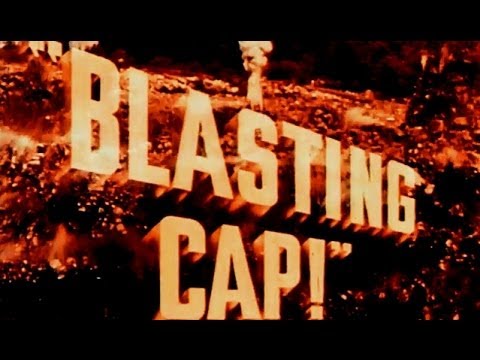more at
‘Shows the dangers to which children expose themselves when they play with blasting caps.’
NEW VERSION with improved video & sound:
Public domain film from the Prelinger Archives, slightly cropped to remove uneven edges, with the aspect ratio corrected, and mild video noise reduction applied.
The soundtrack was also processed with volume normalization, noise reduction, clipping reduction, and/or equalization (the resulting sound, though not perfect, is far less noisy than the original).
Wikipedia license:
A blasting cap is a small sensitive primary explosive device generally used to detonate a larger, more powerful and less sensitive secondary explosive such as TNT, dynamite, or plastic explosive.
Blasting caps come in a variety of types, including non-electric caps, electric caps, and fuse caps. They are used in commercial mining, excavation, and demolition. Electric types are set off by a short burst of current conducted from a blasting machine by a long wire to the cap to ensure safety. Traditional fuse caps have a fuse which is lit by a match.
The need for blasting caps arises from sensitivity issues of an explosive compound. All explosive compounds require a certain amount of energy to detonate. If an explosive is too sensitive, it may go off unexpectedly, so most commercial explosives are formulated to be stable and safe to handle and will not explode if accidentally dropped, mishandled, or exposed to fire. However, such explosives (called secondary explosives) are hard to detonate intentionally as well, and require a small initiating explosion. A blasting cap contains an easy-to-ignite explosive that provides the initial activation energy to start a detonation in a more stable explosive. The blasting cap is stored separately and not inserted into the main explosive charge until just before use, keeping the main charge safe.
Most blasting caps contain what is called a primary explosive, which is a high explosive compound that will explode from flame, heat or shock. A blasting cap may also contain a booster, another less sensitive but more energetic explosive that makes the cap more powerful, and thus more reliable for detonating secondary explosives.
Explosives commonly used in blasting caps include mercury fulminate, lead azide, lead styphnate and tetryl. The recommended primary explosive is DDNP because it is nontoxic, easy to make and not too sensitive.
Because they contain easy-to-detonate primary explosives, blasting caps are hazardous for untrained personnel to handle. They are sometimes not recognized as explosives due to their appearance, leading to injuries.

